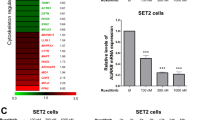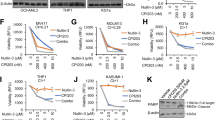Abstract
Small molecule inhibition of the BET family of proteins, which bind acetylated lysines within histones, has been shown to have a marked therapeutic benefit in pre-clinical models of mixed lineage leukemia (MLL) fusion protein-driven leukemias. Here, we report that I-BET151, a highly specific BET family bromodomain inhibitor, leads to growth inhibition in a human erythroleukemic (HEL) cell line as well as in erythroid precursors isolated from polycythemia vera patients. One of the genes most highly downregulated by I-BET151 was LMO2, an important oncogenic regulator of hematopoietic stem cell development and erythropoiesis. We previously reported that LMO2 transcription is dependent upon Janus kinase 2 (JAK2) kinase activity in HEL cells. Here, we show that the transcriptional changes induced by a JAK2 inhibitor (TG101209) and I-BET151 in HEL cells are significantly over-lapping, suggesting a common pathway of action. We generated JAK2 inhibitor resistant HEL cells and showed that these retain sensitivity to I-BET151. These data highlight I-BET151 as a potential alternative treatment against myeloproliferative neoplasms driven by constitutively active JAK2 kinase.
This is a preview of subscription content, access via your institution
Access options
Subscribe to this journal
Receive 12 print issues and online access
$259.00 per year
only $21.58 per issue
Buy this article
- Purchase on Springer Link
- Instant access to full article PDF
Prices may be subject to local taxes which are calculated during checkout







Similar content being viewed by others
References
Adamson JW, Fialkow PJ, Murphy S, Prchal JF, Steinmann L . Polycythemia vera: stem-cell and probable clonal origin of the disease. N Engl J Med 1976; 295: 913–916.
Fialkow PJ, Faguet GB, Jacobson RJ, Vaidya K, Murphy S . Evidence that essential thrombocythemia is a clonal disorder with origin in a multipotent stem cell. Blood 1981; 58: 916–919.
Campbell PJ, Baxter EJ, Beer PA, Scott LM, Bench AJ, Huntly BJ et al. Mutation of JAK2 in the myeloproliferative disorders: timing, clonality studies, cytogenetic associations, and role in leukemic transformation. Blood 2006; 108: 3548–3555.
Baxter EJ, Scott LM, Campbell PJ, East C, Fourouclas N, Swanton S et al. Acquired mutation of the tyrosine kinase JAK2 in human myeloproliferative disorders. Lancet 2005; 365: 1054–1061.
Kralovics R, Passamonti F, Buser AS, Teo SS, Tiedt R, Passweg JR et al. A gain-of-function mutation of JAK2 in myeloproliferative disorders. N Engl J Med 2005; 352: 1779–1790.
Levine RL, Wadleigh M, Cools J, Ebert BL, Wernig G, Huntly BJ et al. Activating mutation in the tyrosine kinase JAK2 in polycythemia vera, essential thrombocythemia, and myeloid metaplasia with myelofibrosis. Cancer Cell 2005; 7: 387–397.
Zhao R, Xing S, Li Z, Fu X, Li Q, Krantz SB et al. Identification of an acquired JAK2 mutation in polycythemia vera. J Biol Chem 2005; 280: 22788–22792.
James C, Ugo V, Le Couedic JP, Staerk J, Delhommeau F, Lacout C et al. A unique clonal JAK2 mutation leading to constitutive signalling causes polycythaemia vera. Nature 2005; 434: 1144–1148.
Mullally A, Lane SW, Ball B, Megerdichian C, Okabe R, Al-Shahrour F et al. Physiological Jak2V617F expression causes a lethal myeloproliferative neoplasm with differential effects on hematopoietic stem and progenitor cells. Cancer Cell 2010; 17: 584–596.
Li J, Spensberger D, Ahn JS, Anand S, Beer PA, Ghevaert C et al. JAK2 V617F impairs hematopoietic stem cell function in a conditional knock-in mouse model of JAK2 V617F-positive essential thrombocythemia. Blood 2010; 116: 1528–1538.
Dawson MA, Bannister AJ, Gottgens B, Foster SD, Bartke T, Green AR et al. JAK2 phosphorylates histone H3Y41 and excludes HP1alpha from chromatin. Nature 2009; 461: 819–822.
Hernandez-Boluda JC, Alvarez-Larran A, Gomez M, Angona A, Amat P, Bellosillo B et al. Clinical evaluation of the European LeukaemiaNet criteria for clinicohaematological response and resistance/intolerance to hydroxycarbamide in essential thrombocythaemia. Br J Haematol 2011; 152: 81–88.
Harrison C, Kiladjian JJ, Al-Ali HK, Gisslinger H, Waltzman R, Stalbovskaya V et al. JAK inhibition with ruxolitinib versus best available therapy for myelofibrosis. N Engl J Med 2012; 366: 787–798.
Verstovsek S, Mesa RA, Gotlib J, Levy RS, Gupta V, DiPersio JF et al. A double-blind, placebo-controlled trial of ruxolitinib for myelofibrosis. N Engl J Med 2012; 366: 799–807.
Verstovsek S, Kantarjian H, Mesa RA, Pardanani AD, Cortes-Franco J, Thomas DA et al. Safety and efficacy of INCB018424, a JAK1 and JAK2 inhibitor, in myelofibrosis. N Engl J Med 2010; 363: 1117–1127.
Koppikar P, Bhagwat N, Kilpivaara O, Manshouri T, Adli M, Hricik T et al. Heterodimeric JAK-STAT activation as a mechanism of persistence to JAK2 inhibitor therapy. Nature 2012; 489: 155–159.
Barbieri I, Cannizzaro E, Dawson MA . Bromodomains as therapeutic targets in cancer. Brief Funct Genomics 2013; 12: 219–230.
Yang Z, Yik JH, Chen R, He N, Jang MK, Ozato K et al. Recruitment of P-TEFb for stimulation of transcriptional elongation by the bromodomain protein Brd4. Mol Cell 2005; 19: 535–545.
Dawson MA, Prinjha RK, Dittmann A, Giotopoulos G, Bantscheff M, Chan WI et al. Inhibition of BET recruitment to chromatin as an effective treatment for MLL-fusion leukaemia. Nature 2011; 478: 529–533.
Zuber J, Shi J, Wang E, Rappaport AR, Herrmann H, Sison EA et al. RNAi screen identifies Brd4 as a therapeutic target in acute myeloid leukaemia. Nature 2011; 478: 524–528.
Delmore JE, Issa GC, Lemieux ME, Rahl PB, Shi J, Jacobs HM et al. BET bromodomain inhibition as a therapeutic strategy to target c-Myc. Cell 2011; 146: 904–917.
Mertz JA, Conery AR, Bryant BM, Sandy P, Balasubramanian S, Mele DA et al. Targeting MYC dependence in cancer by inhibiting BET bromodomains. Proc Natl Acad Sci USA 2011; 108: 16669–16674.
Godfrey AL, Chen E, Pagano F, Ortmann CA, Silber Y, Bellosillo B et al. JAK2V617F homozygosity arises commonly and recurrently in PV and ET, but PV is characterized by expansion of a dominant homozygous subclone. Blood 2012; 120: 2704–2707.
Hirose K, Inukai T, Kikuchi J, Furukawa Y, Ikawa T, Kawamoto H et al. Aberrant induction of LMO2 by the E2A-HLF chimeric transcription factor and its implication in leukemogenesis of B-precursor ALL with t(17;19). Blood 2010; 116: 962–970.
Calero-Nieto FJ, Joshi A, Bonadies N, Kinston S, Chan WI, Gudgin E et al. HOX-mediated LMO2 expression in embryonic mesoderm is recapitulated in acute leukaemias. Oncogene 2013;; e-pub ahead of print 27 May 2013; doi:10.1038/onc.2013.175.
Oram SH, Thoms JA, Pridans C, Janes ME, Kinston SJ, Anand S et al. A previously unrecognized promoter of LMO2 forms part of a transcriptional regulatory circuit mediating LMO2 expression in a subset of T-acute lymphoblastic leukaemia patients. Oncogene 2010; 29: 5796–5808.
Ma AC, Ward AC, Liang R, Leung AY . The role of jak2a in zebrafish hematopoiesis. Blood 2007; 110: 1824–1830.
Pardanani A, Gotlib JR, Jamieson C, Cortes JE, Talpaz M, Stone RM et al. Safety and efficacy of TG101348, a selective JAK2 inhibitor, in myelofibrosis. J Clin Oncol 2011; 29: 789–796.
Nam CH, Rabbitts TH . The role of LMO2 in development and in T cell leukemia after chromosomal translocation or retroviral insertion. Mol Ther 2006; 13: 15–25.
McCormack MP, Forster A, Drynan L, Pannell R, Rabbitts TH . The LMO2 T-cell oncogene is activated via chromosomal translocations or retroviral insertion during gene therapy but has no mandatory role in normal T-cell development. Mol Cell Biol 2003; 23: 9003–9013.
McCormack MP, Young LF, Vasudevan S, de Graaf CA, Codrington R, Rabbitts TH et al. The Lmo2 oncogene initiates leukemia in mice by inducing thymocyte self-renewal. Science 2010; 327: 879–883.
Dawson MA, Curry JE, Barber K, Beer PA, Graham B, Lyons JF et al. AT9283, a potent inhibitor of the Aurora kinases and Jak2, has therapeutic potential in myeloproliferative disorders. Br J Haematol 2010; 150: 46–57.
Acknowledgements
We thank members of the Kouzarides laboratory for the thoughtful discussion. The Kouzarides laboratory was supported by Cancer Research UK, Leukaemia and Lymphoma Research, GlaxoSmithKline and BBSRC. Work in the Green laboratory is supported by Leukemia and Lymphoma Research, Cancer Research UK, the Kay Kendall Leukaemia Fund, the NIHR Cambridge Biomedical Research Centre, the Cambridge Experimental Cancer Medicine Centre, and the Leukemia and Lymphoma Society of America. The Gottgens laboratory was supported by Cancer Research UK and Leukaemia and Lymphoma Research, UK. The Huntly laboratory was supported by Cancer Research UK and Leukaemia and Lymphoma Research, UK. MA Dawson is a Wellcome Trust Beit Fellow and E Cannizzaro and M Wiese are funded by this Fellowship.
Author information
Authors and Affiliations
Corresponding author
Ethics declarations
Competing interests
T Kouzarides is a founder of Abcam Ltd. RK Prinja and I Rioja are employees and shareholders of GlaxoSmithKline. The remaining authors declare no conflict of interest.
Additional information
Supplementary Information accompanies this paper on the Leukemia website
Supplementary information
Rights and permissions
About this article
Cite this article
Wyspiańska, B., Bannister, A., Barbieri, I. et al. BET protein inhibition shows efficacy against JAK2V617F-driven neoplasms. Leukemia 28, 88–97 (2014). https://doi.org/10.1038/leu.2013.234
Received:
Accepted:
Published:
Issue Date:
DOI: https://doi.org/10.1038/leu.2013.234
Keywords
This article is cited by
-
Targeted Therapy for MPNs: Going Beyond JAK Inhibitors
Current Hematologic Malignancy Reports (2023)
-
Bromodomain biology and drug discovery
Nature Structural & Molecular Biology (2019)
-
Targeting nuclear β-catenin as therapy for post-myeloproliferative neoplasm secondary AML
Leukemia (2019)
-
Novel BET protein proteolysis-targeting chimera exerts superior lethal activity than bromodomain inhibitor (BETi) against post-myeloproliferative neoplasm secondary (s) AML cells
Leukemia (2017)
-
Non-kinase targets of protein kinase inhibitors
Nature Reviews Drug Discovery (2017)



